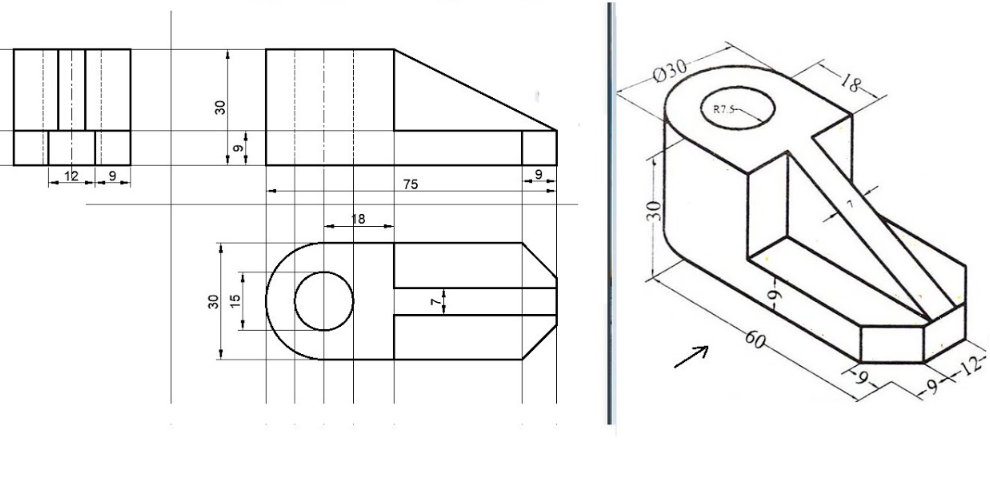The front sight is frequently the most well-known element of a technical drawing. The primary objective of the front view is to deliver a clear, uncomplicated representation of the things that emphasizes essential features, measurements, and proportions.
Structure upon this, the leading view enhances the façade by supplying information regarding the deepness of the object. This sight permits designers to see just how wide and deep the item is, removing uncertainty that might arise from the preliminary front sight alone. The top sight aids to imagine partnerships between different aspects of the design, making it simpler to recognize the layout of elements, specifically in elaborate systems with several overlapping parts. When used properly, the top view can aid communicate vital facets of functionality and spatial arrangement that are crucial for making and assembly.
The side view, also known as the profile view, offers yet another perspective by depicting the object's height and depth. By incorporating the side sight right into the technical drawing, developers make certain that all measurements can be properly offered, producing a detailed view of the item.
Check out technical drawing views the important role of technical drawing in engineering and architecture, highlighting key views such as front, top, side, area, and isometric viewpoints that make certain specific interaction and implementation in style and manufacturing.
Area views are one more vital part of technical illustrations. They offer a method to portray the internal attributes of a style that may not be obvious from the external views. An area sight is developed by cutting through the object and revealing its interior geometry.
One more valuable strategy in technical drawing is isometric forecast. This view supplies a three-dimensional depiction of the item, providing a useful impression of deepness and scale without requiring intricate point of view calculations. Isometric views can be extremely beneficial in sharing the general layout of an item, especially to people who might not be skilled in reading technical drawings. While isometric estimates fall brief of representing real point of view, they remain a preferred option for presenting concepts clearly and understandably. When comments and repetitive enhancement are essential, this makes them specifically valuable during the very early style phases.
In enhancement to these fundamental views, there are various other kinds of estimates, such as orthographic and perspective forecasts, that offer various features in technical drawing. Orthographic projections are a collection of several views that individually represent the object from different angles, normally in a two-dimensional layout.

To successfully produce a technical drawing, it is vital to understand the conventions and symbols that represent various attributes and measurements. Architects and designers make use of numerous lines-- such as strong lines, rushed lines, and centerlines-- to convey information about edges, functions, and crucial places. Dimensioning is an additional essential part of technical drawing. Proper dimensioning provides important measurements that dictate how elements mesh, making sure that layouts fulfill essential resistances and requirements. Inaccurate dimensions can lead to costly mistakes during manufacturing, making this aspect of technical drawing essential for reliability and success.
In addition, numerous software application devices and applications assist in the technical drawing procedure, boosting the standard hand-drawing approaches. Programs like AutoCAD, SolidWorks, and other Computer-Aided Design (CAD) software allow users to create intricate 2D and 3D versions with much better accuracy and versatility than hands-on methods. These tools enable easy modifications, allowing for quick prototyping and model without the demand to recreate illustrations from scratch. This digital transformation has considerably accelerated the layout and manufacturing processes across countless sectors, driving advancement and improving efficiency.
In the context of markets today, understanding just how to apply various views in technical drawing is not only crucial for designers and designers but additionally for producers, item developers, and even marketing professionals. In collective settings, especially in fields like building and manufacturing, clear technical illustrations guarantee that all stakeholders-- from developers to clients-- are on the very same page.
Moreover, with the increase of 3D printing and additive manufacturing, the value of accurate technical drawing comes to be even extra noticable. As these technologies proceed to evolve, they need detailed specs to ensure that physical designs properly symbolize the initial design. The capacity to from extensive technical illustrations, including several views, is essential for producing components that not only mesh correctly however also operate successfully as part of more comprehensive systems. Additionally, as markets change to automated and electronic procedures, the skills required to produce and translate technical illustrations will be vital to future ability pipelines.
In final thought, technical drawing includes different views, each of which plays a certain function in communicating needed info regarding an item. As innovation and approaches for producing technical drawings continue to advance, understanding and implementing these views effectively remains paramount. As we relocate better right into a period defined by fast technological development, the principles of technical drawing and its accompanying views will undoubtedly remain essential in forming the future of layout, design, and production.